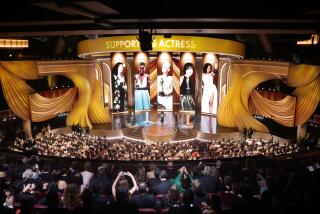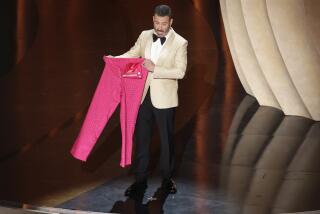Cinematographers Edge Into the Limelight : Oscars: The distinctive styles of the five nominees amply demonstrate why the craft’s stock is rising.
There are frequent complaints that the Academy Award telecast is too long. In fact, the agreement between the motion-picture academy and the ABC network stipulates that the show cannot be less than three hours long. How else to get in all those commercials.
Still, there are suggestions that some of the “lesser” awards be sent by mail--a thought greeted by rightful indignation in the industry. What is Batman going to do without special effects, take the stairs? And what would “The Hunt for the Red October” and any number of other films do without their apt and ingenious sound effects?
In fact, audiences are smarter all the time about the work of the below-the-line technicians who don’t get salads named after them but without whom movies would have only a fraction of their impact. Viewers have even come to realize that the actors don’t make up the words, and certainly not the deeds, as they go along. There are writers, dyspeptic but ever-hopeful, involved.
Probably the latest craft to win a widening recognition outside the industry ghetto are the cinematographers. It is clear that, subject matter and location aside, all films do not look alike. In black-and-white days, you couldn’t mistake the contrasty and menacing shadows of a Warners film with the sunny, creamy lights of a typical MGM film.
In Britain, the cinematographers are more often known as lighting cameramen and, in a way, it’s a more fitting title; it’s not the taking of the images that counts, it’s the shaping of the light.
The differences are subtler in these days of color and the technological challenges more dramatic, involving as they frequently do the melding of live action with special effects.
This year’s five Academy Award nominees for cinematography suggest the range of the challenges and the contribution of the person behind the camera to the total picture.
Mikael Salomon’s images for “The Abyss,” for example, involved mind-boggling difficulties of underwater action and of sequences done in claustrophobic spaces of the undersea vehicles. It’s a film in which what you see counts for more than what you think or feel emotionally, and Salomon’s work earned its nomination, along with the picture’s other nominations for art direction, sound and visual effects.
The commercially disappointing Paul Newman film, “Blaze,” in which he played Louisiana politician Earl Long, received only one nomination, but it was for Haskell Wexler’s cinematography. The nomination is his fifth and he has two Oscars, for “Who’s Afraid of Virginia Woolf?” and “Bound for Glory.” He’s also photographed films as various as “One Flew Over the Cuckoo’s Nest” and “The Thomas Crown Affair.”
Wexler’s approach is what could be called a poetic naturalism, events taking place in the seeming absence of artificial light or in the presence of whatever the available light was. It is cinematography that, seeking to conceal itself, has become a valued signature, as it is in “Blaze.”
“Medium Cool,” Wexler’s own feature, which was made during the tumultuous Democratic convention in Chicago in 1968 and placed fictional characters amid the actual chaos, prefigured the kind of dramatic re-creations of history Robert Richardson would be asked to photograph for Oliver Stone in “Born on the Fourth of July,” and for which he received one of the film’s eight nominations. The visual tasks, from a high school prom to grueling combat sequences, a rat-infested hospital and several riots, were, to say the least of it, varied and demanding.
The German-born veteran cinematographer Michael Ballhaus, who has shot 80 films in 27 years, including 15 with Rainer Werner Fassbinder, was nominated for “The Fabulous Baker Boys.” Ballhaus moved to the United States in 1982 to do “Baby It’s You” with John Sayles. For Martin Scorsese, he photographed “The Color of Money,” “After Hours,” “The Last Temptation of Christ” and, most recently, “Nice Fellas.” His work on “Broadcast News” gave him his first Oscar nomination.
Michelle Pfeiffer’s sexy singing of “Makin’ Whoopee” atop a grand piano, arguably the high point of “Baker Boys,” was, Ballhaus pointed out the other day, a 360-degree camera orbit. “One of my favorite moves if it’s right for the scene,” Ballhaus said. The camera, like a dance partner, not only makes its circle but glides in and out and rises and falls--echoing, in a sense, the eloquent writhings of the actress.
The British veteran Freddie Francis, who won an Oscar for his work on “Sons and Lovers” in 1960, has been nominated for “Glory,” the story of a black regiment in the Civil War. Francis also filmed “The Elephant Man” and such earlier black-and-white classics as “Room at the Top” and “Saturday Night and Sunday Morning.” “The French Lieutenant’s Woman,” in color, was a remarkable blending of a modern reality and an historic romanticism. “Glory” is its own blending--of intimacy and scale--and the battle scenes Francis photographed are quite extraordinary.
As in many other categories of the Academy Awards this year, it is well nigh impossible to predict where the Oscar for cinematography might go. And, too, as in other categories, there are allowable tips of the hat to cinematographers who didn’t make the cut but might have: Miroslav Ondricek of “Valmont,” John Seale of “Dead Poets Society,” John A. Alonzo of “Steel Magnolias,” Robert Yeoman of “Drugstore Cowboy,” Ernest Dickerson of “Do the Right Thing,” to name a second five.
More to Read
Only good movies
Get the Indie Focus newsletter, Mark Olsen's weekly guide to the world of cinema.
You may occasionally receive promotional content from the Los Angeles Times.










